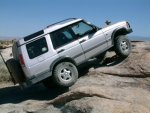I've been on a couple of trips in the Sierra's recently that involved rocks.
http://www.mcune.com/gallery/BlueLakes07102004/IMG_2175
What is the best way to deal with a field of boulders?
Once I get started, I tend to keep going. I keep it slow and steady and let the ETC carry me over everything. This works great, but the truck bounces a lot and there is a high potential for damage.
Is it better to keep moving or try to take one rock at a time?
I'm driving a D2 with CDL , traction control and open diffs.
Thanks for your insight.
Mike
http://www.mcune.com/gallery/BlueLakes07102004/IMG_2175
What is the best way to deal with a field of boulders?
Once I get started, I tend to keep going. I keep it slow and steady and let the ETC carry me over everything. This works great, but the truck bounces a lot and there is a high potential for damage.
Is it better to keep moving or try to take one rock at a time?
I'm driving a D2 with CDL , traction control and open diffs.
Thanks for your insight.
Mike
